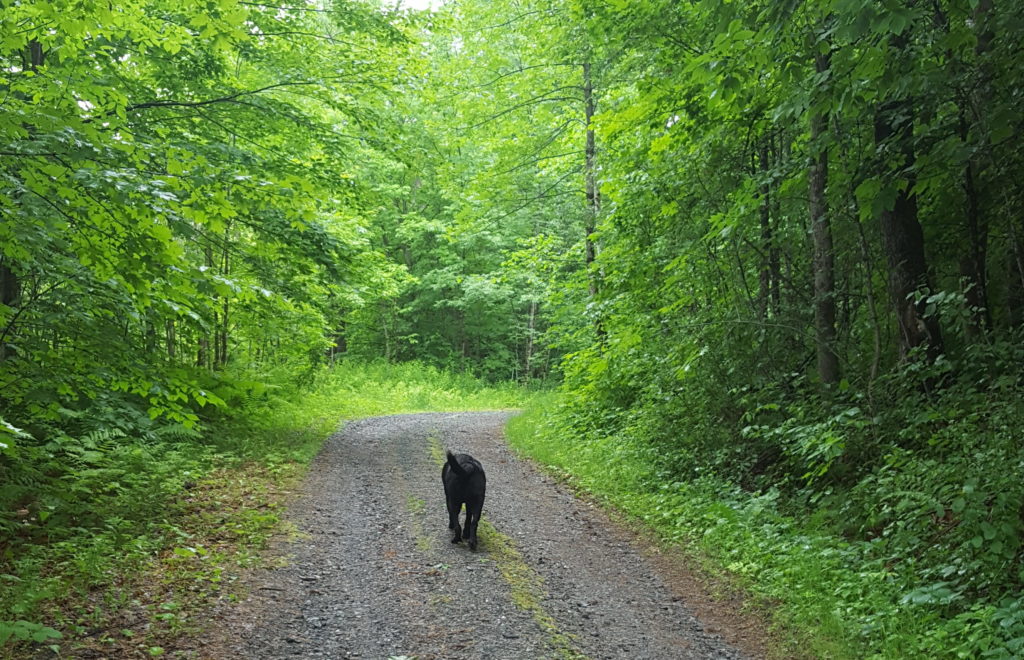
by Caroline DeMaio
“Walking is the great adventure, the first meditation, a practice of heartiness and soul primary to humankind. Walking is the exact balance between spirit and humility.”
— Gary Snyder
I have been a walker for most of my life. By walker I mean someone who goes for walks short and long, for exercise and enjoyment. During this time of lockdown and quarantine, I have been particularly thankful to live in a place where I can walk out my front door and down a dirt road or into the woods.
To be outside in the fresh air moving through space has been a way to get out of my thinking mind and down into my body. It has certainly been beneficial for my health. My aching knees have become more flexible. Getting lungs working seems of great importance for our well-being, and walking slowly or vigorously leaves my whole body feeling refreshed.
For further motivation, I also have the benefit of a dog, a large black lab named Pepper, who needs to walk even more than I do and whose enthusiasm for the journey helps to lighten any dark mood I might be in. Pepper is so enthralled by the sights and smells, (mostly smells) of a walk through the woods that his meandering route must be five times as long as my more linear one. I have learned that a dog’s nose contains 300 million olfactory sensors as compared to our 60 million, which is why I have tried in vain to catch a whiff of whatever scent it is that has caught his focus.
Watching Pepper’s curiosity has increased my own. On our walk today, following a downpour, I was pleased to be able to smell the earth and the foliage underfoot. I recently learned that there is a name for this phenomenon, the smell after rain, which is petrichor. Increased awareness and curiosity are a big part of why I love to walk.
I often find that a good walk will wake me up, and bring my mind more into focus, but almost as often I can get caught up in a thought or scenario which takes me out of my body altogether. Fortunately, in order to stay upright, without tripping over rocks or other obstacles I need to continuously bring my mind back: back to my feet, to the feeling of the ground beneath them, to my body breathing.
Anyone who enjoys regular walks probably already knows about these benefits, but as someone who has practiced mindfulness meditation for years, I have noticed that the practice of purposeful walking meditation makes use of the ability and need that we have to synchronize our body and mind. The process of noticing how our mind wanders and then bringing it gently back to being present in our body, over and over again, is a natural extension of the meditation practice we do on our cushion. It is a simple and universal practice for developing calmness, connectedness, and embodied awareness.
As an extension of sitting meditation which takes us off our meditation seat and into the world, walking meditation is an excellent transition from formal practice into our environment and our life. The Vietnamese monk Thich Nhat Hanh says “Walking meditation is first and foremost a practice to bring body and mind together peacefully.”
While it can be done at any time, it’s especially beneficial when done before, during or after regular mindfulness practice. It can be done for any amount of time, but 10 – 15 minutes is recommended by most traditions. Walking meditation can be done in a city or suburb, as well as in a more natural setting. Since it is slow and focused it is good to choose a place where there are few people. Many teachers have descriptions of how to practice walking meditation, all mostly similar. Here are some steps I find to be helpful in developing a walking meditation practice:
- Choose a place to walk. If outside it should be easy terrain, quiet, and not too long. You can walk in a circle or back and forth along a path. You can also do walking meditation inside, going around your room or your house. Decide how long you will walk and commit to that time.
- Wear comfortable shoes and clothes for the weather
- Start by feeling your body, feet on the ground, relaxed. Feel your breathing.
- Bring your attention to your feet. Notice as you pick up one foot and place it on the ground, then the other foot, bringing your attention to the feeling of your feet walking. Let your hands hang loosely by your side, or fold them in front by your belly or behind your back, whatever is most comfortable.
- Have a sense of an upright head and shoulders, with a straight spin, feeling the sky above and the earth below.
- Walk at a pace which allows mindfulness. This is usually a slow pace.
- When attention wanders bring it back to your feet walking. Whatever thoughts you have had, notice them and gently return to your feet walking.
- Take a few minutes to expand your attention to sounds. Whatever you are hearing, indoors or out, bring your full attention to it.
- Shift your awareness to smells. Simply notice what you smell. No need to force anything. Just notice what arises.
- Lastly bring your attention to sight, the colors and objects around you. and notice how attending to your senses opens your awareness out to the world
- Return to standing still, coming back to being in your body, standing on the earth. Continue walking with attention on your feet.
- Return to where you started your walk.
These steps are suggestions, ones which have proved helpful to me. Feel free to adjust and supplement from your own experience. Essentially, the experience of feeling our feet connecting to the earth while our body connects to the environment around us is a very energizing experience.
Walking meditation is not about getting somewhere; it is about developing our awareness of being present in our body, in the moment. It is an extension and enrichment of our meditation practice. As Thich Nhat Hahn says, “ With each step we fully arrive at the present moment.”
